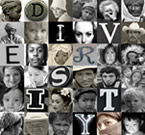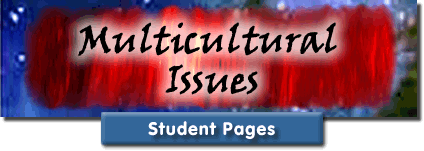|
|

•
•
•
•
•
•
•
•
•
•
•
•
•
•
•
•
•
•
•
•
•
•
•
•
•

|
|

What is Age
February 27, 2009  A constant failing on my part, in the arena of the arts, is the construction of anything visual — be it a scrapbook of memories, a charcoaled heart, or even a rickety interpretation of a stick figure (and their angled, misshapen house). Computer graphics, too, are somehow scared by my attempts at any visual renditions. Due to my artistic ineptitude (and fear of a RAM revolt on my computer’s part), I’ve chosen a logo pieced together by someone far more talented in graphical representation. The logo stitches together, into a cohesive square, various photographs of people of all ages and cultures. Sprinkled throughout the photographs are letters that spell “DIVERSITY.” Diversity, in my opinion, is the backbone of a multicultural learning environment. As a teacher, I want — and need — to understand all of the different faces (and more importantly, the people behind the faces) represented in this logo. Teacher learning (Principle I) is the beginning of a multicultural classroom, the basis for establishing a climate in the classroom that values and respects the distinct cultures of each individual student. Student learning (principles 2-4) is represented in the chosen logo due to the shape of the logo itself: a square. One person or culture doesn’t take precedent inside the square, just as it should be in a multicultural classroom. The construct of the square and the fitting of all of the images is relevant to my experience with imagery; another student, for example, might piece together images in an altogether different manner (and should be encouraged to do so, based on their own cultural experiences). Within this construct, in stark, revealing photographs, different cultures and ages preside. The connection of all of the people in the photographs, small square to each small square, symbolizes Intergroup Relations (principles 5-9) and the importance of intergroup relations to a multicultural classroom. Students should be encouraged to learn about one another — what is the story of the person there, in that picture, with the Mohawk?; or the small child holding a candle to his face? — in an accepting environment. A teacher needs to establish an open, welcoming classroom that stimulates conversation and interest about other cultures. The logo stirs many questions, and hopefully many interesting answers, about the many people and cultures presented in the photographs. As for principles 10-11, regarding School Governance, Organization and Equity, the logo entails a collaboration of all of the photographs to create the whole. All of the people within the photographs share equal importance within the square, just as schools and administration need to ensure that everyone (the whole diverse student body) receives equal attention, be it in curriculum decisions, or in observed holidays. How I, as a teacher, view the varying people and cultures in the photographs also relates to principle 12, Assessment, in the respect that I need to recognize the culturally specific learning that my students have been a part of. When assessing students and their learning, I need to be aware of their cultural backgrounds to better understand how their cultures might affect their learning or how I assess their learning. Ultimately, my chosen MC Logo represents the uniqueness of the individual and their culture, while also stitching together disparate people into a cohesive whole under the welcoming and open banner of diversity. Hopefully, I can create a classroom mirroring this logo and the ideas it represents. January, 2009
For a printer-friendly copy
For a printer-friendly copy
|
|
|


